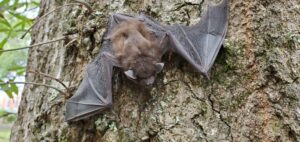Bats
The wind whooshes by your ear as something flies way too close to comfort. You automatically cover your head as you look around and spot the culprit…a bat!!! As night falls, you’ve probably seen the dark shape of a bat flying above you as it begins its nightly hunt. Bats are the second largest group of mammals, and they make up around one-fifth of all mammals in the world. The state of Georgia is home to 16 species of bats. Since there are so many varieties, bats inhabit every part of the world, including your backyard. Bats live in every part of the North American continent and help in the pollination and insect population control in their respective habitats.
Unfortunately, bats are known to sometimes carry rabies, which has a high mortality rate in humans if not treated quickly and properly. Despite their bad reputation, bats are very beneficial because of their assistance in controlling disease-carrying insects.
To rest, bats need an area to roost and rest during the daytime hours. Sadly, as urban areas have grown, bat populations close to residential areas have had an increase in contact with people. Bats seek out darkened spaces to build their roosts and are also known for living in at- tics, barns, and other dark, enclosed spaces. Often homeowners realize they have bats when they find guano (bat excrement) either near vents or on the floor of attics. The guano itself can carry dangerous pathogens and should be handled with care.
If you find a bat in your home, remember to be careful since they can carry rabies and could hurt themselves if they panic. They have fragile, easily damaged wings and are almost impossible to catch while in flight. Extermination is not the answer when dealing with bats. Bats are ac- actually protected by conservation laws provided by the federal government. It is important to remember it is a crime to harm or mishandle a bat. There are very good reasons for these laws. Our ecosystem relies on bats to keep the insect population in balance. Insects cause tremendous numbers of diseases and are dangerous to humans. If bats are inside a commercial or residential residence, it is permissible to remove them from the structure. The winter is hibernation time for bats and if they are awakened prematurely, they could die. But a bat infestation can be a health hazard for anyone living near to them and needs to be dealt with as soon as possible.
A trained professional should be called for any bat removal procedures. It is difficult, some- times dangerous work that should be left to a trained company. At Canton Termite and Pest Control, we have done hundreds of bat removal jobs, and we are the most efficient and skilled team for solving your bat problems. Your safety is our first priority, as well as caring for the health of the helpful, insect-eating bats. Our work will seek to remove the bats from home areas and relocate them to safe environments. Our next job is to seal problem areas around the home in order to prevent bats from getting back into your house again. Don’t forget that even if you do not currently have a bat problem, your house could become infested if it is not sealed properly. As the old saying goes, prevention is the best cure. Our experience in the industry can help prevent a problem before it occurs. Proper sealing is essential. Be proactive!
Do you have a bat problem in your home? We can take care of that for you! Just give us a call or text us at 770-479-1598 Any other pest problems? Check out our primary website at CantonTermite.com.
By: Tim
Want more info on bats? check out these resources! Georgia DNR: http://georgiawildlife.com/Conservation/Bats
Bat Conservation Trust: http://www.bats.org.uk/pages/bats_of_the_world.html
CDC: http://www.cdc.gov/rabies/
